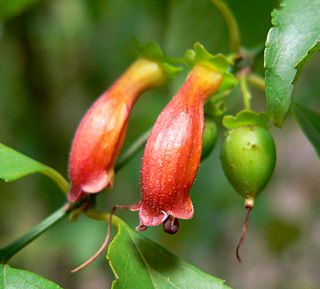Oligothrix is a genus of flowering plants in the groundsel tribe within the sunflower family.
Adenoglossa is a genus of flowering plants in the daisy family described as a genus in 1976. There is only one known species, Adenoglossa decurrens, endemic to South Africa.
Marasmodes is a genus of South African shrubs in the chamomile tribe within the daisy family.

Halleria is a genus of flowering plants in the family Stilbaceae described as a genus by Linnaeus in 1753.
Tenaris is a genus of plant in family Apocynaceae, first described as a genus in 1838. It is native to southern Africa.
- Tenaris brownianaS. Moore - Angola
- Tenaris chloranthaSchltr. - South Africa
- Tenaris filifolia(Schltr.) N.E. Br. - South Africa
- Tenaris schultzei(Schltr.) E. Phillips - Kalahari Desert
- Tenaris rubella, syn of Brachystelma rubellum
- Tenaris simulans, syn of Brachystelma rubellum
- Tenaris subaphylla, syn of Caralluma edulis

Tavaresia is a genus of plants in the family Apocynaceae, first described as a genus in 1902. It is native to southern Africa.
- Tavaresia angolensisWelw. - Angola
- Tavaresia barklyi(Dyer) N.E.Br. - South Africa
- Tavaresia grandifloraBerger - South Africa
- Tavaresia meintjesiiR.A. Dyer - Limpopo
Aspidoglossum is a genus of plants in the family Apocynaceae, first described as a genus in 1838. It is native to Africa.
Anisotoma is a genus of flowering plants formerly belonging to the plant family Asclepiadaceae, now considered to be part of the Apocynaceae, first described as a genus in 1844. They are native to South Africa
- Anisotoma cordifoliaFenzl - South Africa
- Anisotoma pedunculataN.E.Br. - KwaZulu-Natal
Cordylogyne is a genus of plants in the family Apocynaceae, first described as a genus in 1838. It contains only one accepted species, Cordylogyne globosa, native to South Africa. Three other names have been proposed in the genus, also native to southern Africa, but at present they are listed as "unresolved," i.e., of uncertain affiliation.
- Cordylogyne argillicolaDinter - Namibia
- Cordylogyne kassnerianum(Schltr.) Eyles - South Africa
- Cordylogyne mossambicense(Schltr.) Eyles - Mozambique

Pachycarpus is a genus of plants in the family Apocynaceae, first described in 1838. It is native to Africa.

Riocreuxia is a plant genus in the family Apocynaceae, and named in honour of the botanical illustrator Alfred Riocreux (1820-1912). It was first described as a genus in 1844 and is native to Africa.
Oncinema is a genus of plants in the family Apocynaceae first described as a genus in 1834. It contains only one known species, Oncinema lineare , native to South Africa.

Orbeanthus is a genus of flowering plants of the family Apocynaceae, first described as a genus in 1978. It is native to South Africa.
- Orbeanthus conjunctus(White & Sloane) L.C. Leach - South Africa
- Orbeanthus hardyi(R.A. Dyer) L.C. Leach - South Africa
Parapodium is a genus of flowering plants of the family Apocynaceae, first described as a genus in 1838. It is native to South Africa.
- Parapodium costatumE.Mey. - South Africa
- Parapodium crispumN.E.Br. - South Africa
- Parapodium simileN.E.Br. - South Africa
Pectinaria is a genus of plants in the family Apocynaceae, first described as a genus in 1819. The entire genus is endemic to South Africa.

Pentarrhinum is a genus of plants in the family Apocynaceae, first described as a genus in 1838. It is native to Africa.
- Pentarrhinum abyssinicumDecne. - E + C + S Africa
- Pentarrhinum balense(Liede) Liede - Ethiopia
- Pentarrhinum coriaceumSchltr. - KwaZulu-Natal
- Pentarrhinum gonoloboides(Schltr.) Liede - Tanzania
- Pentarrhinum insipidumE.Mey. - South Africa
- Pentarrhinum ledermannii(Schltr.) Goyder & Liede - Burundi
- Pentarrhinum somaliense(N.E. Br.) Liede - Somalia
Periglossum is a genus of flowering plants in the family Apocynaceae, first described as a genus in 1844. It is native to southern Africa.
- Periglossum angustifoliumDC. - South Africa
- Periglossum kassnerianumSchltr. - South Africa
- Periglossum mackeniiHarv. - South Africa
- Periglossum macrumDecne. - South Africa
- Periglossum mossambicenseSchltr. - Mozambique

Petopentia, commonly known as propeller vine, is a genus of plant in the family Apocynaceae first described as a genus in 1954. It contains only one known species, Petopentia natalensis, native to the Province of KwaZulu-Natal in eastern South Africa.

Sisyranthus is a group of plants in the family Apocynaceae first described as a genus in 1838. It is native to southern Africa.
Adenanthellum is a genus of flowering plants in the daisy family, Asteraceae described as a genus in 1979.







